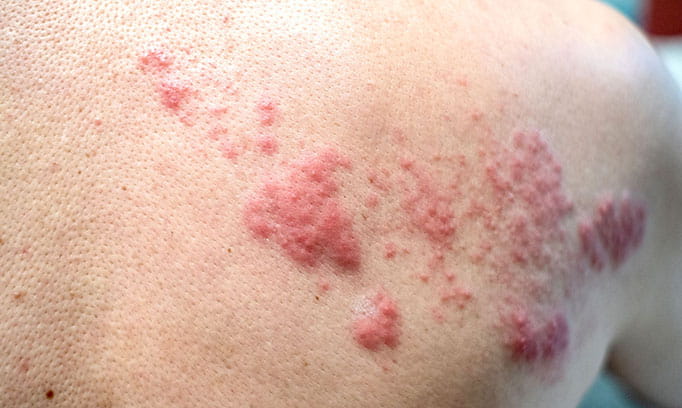
HEAL
Shingles: understanding the symptoms and treatment
Posted September 14, 2020
- The CDC estimates that 1 in 3 Americans will develop shingles during their lifetime.
- Most people get shingles just once, but for others it can recur several times.
- Shingles is most common after age 50, but anyone who has had chickenpox can develop shingles.
If you’ve had chickenpox, even years ago as a child, you are at increased risk for developing shingles. The CDC estimates that one in three Americans will develop shingles during their lifetime. The virus can be dormant for years, then “wake up,” leading to a burning, tingling pain, followed by an itchy, blistery rash called shingles. Shingles can be painful and its effects long-lasting. Most people get shingles just once, but for others, it can recur several times.
The good news is that a vaccine, given to people at 50 years and older, can reduce your risk of developing shingles.
What is shingles?
Shingles is a skin infection caused by the same virus – varicella-zoster – that causes chickenpox. Once chickenpox runs its course, the virus remains in the nerves near your brain and spinal column and can appear again years later. While we don’t know exactly what causes the virus to “wake up,” it is more common in older people and those with a lowered immune system (pregnant women and newborns).
What are the symptoms of shingles?
Shingles typically start with a burning, tingling pain, followed by a painful rash that forms clusters of fluid-filled blisters a few days later. These sores may follow a nerve pathway, showing up as a stripe on one side of your body. While shingles is often found on your chest or back, it can also happen on your face and even in your eyes.
Other symptoms of shingles are:
-
fatigue
-
fever and chills
-
headache
-
sensitivity to touch and light
-
upset stomach.
The shingles blisters dry out and crust over in about five to seven days. The rash usually goes away in about two to six weeks, but shingles pain can last for months or years after the rash heals. Some people have shingles pain but no rash. By age 80, most people have had shingles. Most people get shingles just once, but it can reoccur several times.

Treatment for shingles
Contact your provider as soon as you suspect you may have shingles, especially if it impacts your face or eye. Prescription medications are most effective when taken as soon as possible after the rash appears. Quick treatment can help shorten your infection and reduce complications.
How contagious is shingles?
If you have shingles, you can pass the virus to others who are not immune to chickenpox or who have not had a chickenpox vaccine. It is spread when someone who is not immune comes in direct contact with an open sore. If you have a rash that can’t be covered, you should stay home until seven days after your rash starts and until all your blisters have dried.
If you are immune compromised, or if shingles spreads all over your body there is a small chance that it could be spread through the air like chickenpox to someone who has neither had chickenpox naturally nor had the chickenpox vaccine.
Complications from shingles may include:
-
encephalitis
-
facial paralysis
-
hearing and balance issues
-
long-term pain (post herpetic neuralgia). In some people, shingles pain can continue long after blisters have healed, when damaged nerve fibers continue to send pain messages from your skin to your brain.
-
skin infections
-
vision loss. Shingles in or around an eye can cause a painful eye infection that may lead to vision loss.
To prevent shingles
In addition to the chicken pox vaccine, which can be given to children or adults, two types of shingles vaccines are available for adults. While none of the vaccines totally eliminate your risk of chicken pox or shingles, they can greatly reduce the severity and risk of complications:
-
Zostavax, is a live vaccine and has been around longer. It's a single injection given to people 60 years or older. The vaccine offers protection against shingles for about five years.
-
Shingrix is a newer vaccine for people 50 and older. It is more effective than Zostavax. It is given in two doses, 2-6 months apart, and protects against shingles longer than five years. You can have a Shingrix vaccine after a Zostavax vaccine, as long as at least five years have passed.
Side effects of the vaccine can include headache, and pain, redness, tenderness and itching at the injection site.
You can get a shingles vaccine shot at many clinics. Find a primary care clinic to make an appointment .
Allina Health has many convenient care options, from online visits to walk-in care, to help you get treated quickly for the shingles virus.
-
Get care now
The right care--right away -
Find a provider
Search now
MORE ARTICLES LIKE THIS
Get fun, inspiring, provider-reviewed articles sent to your inbox.
Sign up for our email newsletter





